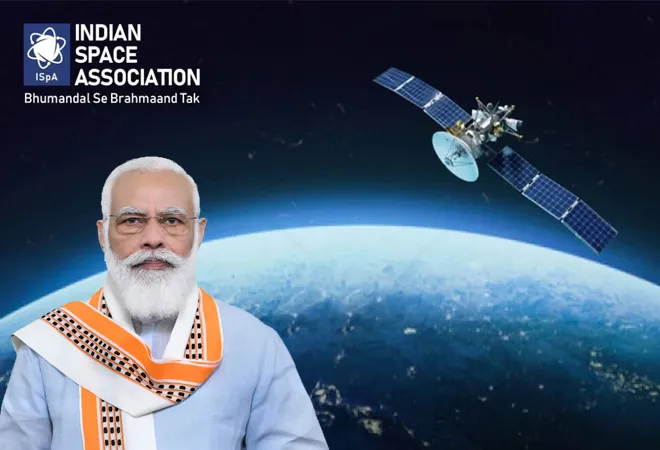Dr. Sudeep Kumar*
The Indian space program has undergone a remarkable transformation under the leadership of Prime Minister Narendra Modi. Over the past decade, the Indian Space Research Organisation (ISRO) has achieved a series of milestones that have pushed the boundaries of scientific exploration and technological advancements with successful missions like Aditya L1, Chandrayaan-3, NAVIC system, IN-SPACe agency, PSLV-C37’s launch of 104 satellites, Mangalyaan and Gaganyaan mission.
The successful launch of the “Aditya L1 mission” on 2nd September 2023 marked an important milestone for solar science. It provides insights into the complex dynamics and processes occurring in the solar corona and chromosphere, which is the source of solar wind and other space weather phenomena and can significantly impact climate, telecommunications, and technology infrastructure on our planet Earth. The data collected by Aditya L1 will contribute to our understanding of the Sun-Earth connection, aid in developing better weather prediction models, and ultimately help mitigate the risks posed by adverse weather events.
One of the most significant accomplishments was the success of the “Chandrayaan-3 mission” on 23rd August 2023, which achieved the historic feat of landing a spacecraft with an orbiter, lander (Vikram), and rover (Pragyan) modules on the lunar south pole region. Despite the hard landing of the Chandrayaan-2 in 2019, the Chandrayaan-3 lander touched down softly on the Moon’s surface and provided insights into the Moon’s geology, composition, and potential for future human exploration and habitation.
On 29th May 2023, the launch of the “NAVIC – India’s indigenous navigational satellite system”, has been a game-changer in terms of reducing the country’s dependence on foreign navigation systems and bolstering our technological self-reliance. ISRO has launched a multitude of satellites for various purposes such as communication, navigation, remote sensing, and weather monitoring.
The establishment of a dedicated nodal agency, the “Indian National Space Promotion and Authorization Center” (IN-SPACe) on 24th June 2020, planned to promote and regulate private sector investments in the space domain. IN-SPACe has paved the way for a more inclusive and collaborative approach to space exploration for entrepreneurship, innovation, and technological advancements. This public-private partnership plans to build and launch satellites, provide space-based services, conduct research & development and create a space ecosystem in India.
ISRO’s launch of 104 satellites with the help of a single Polar Satellite Launch Vehicle (PSLV-C37) on 15th February 2017, demonstrated its ability to execute complex launching operations efficiently. It underscored India’s commitment to providing cost-effective launch services to both domestic and international clients.
The “Mars Orbiter Mission (Mangalyaan)”, successfully launched in its first attempt, on 24th September 2014 provided insights into the red planet’s atmosphere, surface features, and potential for surviving human-life conditions. This low-cost mission (USD 73 million approximately) demonstrated Indian technological prowess and contributed significantly to the scientific community’s understanding of Mars.
The ongoing “Gaganyaan Mission” is India’s first human spaceflight mission, which aims to send astronauts into lower Earth orbit, establishing India as a space power capable of launching crewed missions. Prime Minister Modi recently announced the name of four astronauts (Group Captain Prashanth Balakrishnan, Group Captain Ajith Krishnan, Group Captain Angad Pratap, and Wing Commander Shubhanshu Shukla) for this human spaceflight mission. Moreover, India has unveiled plans to build an Indian Space Station for conducting microgravity experiments, testing technologies during human spaceflight, and possible potential collaborations with international partners. With plans and aspirations for the development of reusable launch vehicles and interplanetary explorations, the Indian space odyssey is poised to reach even greater heights.
Prime Minister Modi’s Space Diplomacy has pursued international collaborations in space exploration and research with the United States, Japan, Russia, France and the European Union to share resources and technological know-how, which resulted in the further strengthening of India’s diplomatic ties worldwide. Domestically, the space program bolstered national pride, inspired a new generation of young minds and ignited their deep interest in science, technology, engineering, and mathematics (STEM). It has further reinforced its commitment to developing an indigenous technological base.
The Modi Era (2014 onwards), indeed reflects the achievements of ISRO, spanning from successful Lunar and Mars missions to the development of an indigenous navigation system and human spaceflight program that have made technological progress and significant achievements in space exploration that led to the recognition of India as a global space power.
*Author has worked in the capacity of Research Fellow at the Indian Council of World Affairs, New Delhi. He is a certified Japanese speaker and can negotiate texts in Mandarin. He completed his doctoral studies (2015-2020) from ECNU, Shanghai and holds a Masters degree in Politics (International Relations) and a MPhil degree in Chinese Studies from Centre for East Asian Studies, School of International Studies, Jawaharlal Nehru University (2020-2015).


Leave a Reply